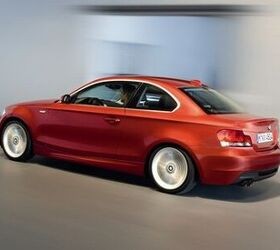The Bmw 135i often sparks debate among car enthusiasts. Is it a budget-friendly entry into BMW performance, or a less refined sibling to the esteemed 335i? Having rigorously tested both the BMW 135i and 335i coupes, we delve into the core question: does the 135i stand on its own merits, or is it perpetually overshadowed by its bigger brother? For those in the market for a performance coupe, the decision hinges on understanding the nuances that separate these two Bavarian machines.
Approaching the BMW 135i, the familiar BMW front end greets you with its double-kidney grille and assertive headlights. There’s an undeniable BMW DNA present, promising a sporty experience. However, moving along the side profile, the design becomes… distinct.
While opinions on styling are subjective, the 135i’s coupe form factor can appear somewhat unconventional. It’s a departure from the classic coupe silhouette, appearing almost as a hatchback in coupe clothing to some eyes. The 335i, in contrast, embodies a more traditionally elegant coupe design. While both share the BMW family face, the 335i often draws comparisons to a more refined aesthetic, whereas the 135i leans towards a more polarizing, perhaps less universally admired look.
Stepping inside the BMW 135i, the interior prioritizes the driver. The cabin design is reminiscent of BMW’s driver-centric ethos of previous years. The sports seats, often trimmed in comfortable leather, immediately set a sporty tone. The dashboard layout is clean and functional, emphasizing usability and direct access to controls. This simplicity is appreciated by those who value a no-nonsense driving environment. However, cost-saving measures are evident in areas like the sun visors, which feel out of place in a car with this performance pedigree. Rear passenger space is also minimal, making it less practical for carrying adults regularly.
In comparison, the 335i’s interior aims for a more premium feel. While still driver-focused, it integrates features like iDrive, which, while adding technological sophistication, can also slightly clutter the dashboard design. The 335i also offers more accommodating rear seats, enhancing its practicality as an all-around vehicle.
Under the hood, both the BMW 135i and 335i share Munich’s celebrated twin-turbocharged 3.0-liter inline-six engine. This powerplant is a marvel of engineering, delivering smooth, potent power across the rev range. Both engines produce 300 horsepower, providing exhilarating performance. In terms of outright acceleration, the lighter BMW 135i exhibits a marginal edge over the 335i, launching slightly quicker off the line. However, this difference is minimal in real-world driving scenarios.
Both test vehicles were equipped with automatic transmissions. These transmissions are responsive, shifting smoothly and intelligently to keep the engine in its optimal power band. However, the automatic transmission in the 135i can feel less refined and slightly slower in its responses compared to the sophisticated ZF unit found in the 335i.
When it comes to handling, the dichotomy between the BMW 135i and 335i becomes more pronounced. The 335i showcases exceptional composure and balance in corners. Its chassis absorbs road imperfections effectively, maintaining stability even on uneven surfaces. Pushing the 335i rewards the driver with increasing confidence and control. It’s a car that flatters the driver, making even challenging roads feel manageable.
The 135i presents a different character. On a track environment, the 135i comes alive. Its agility and responsiveness are heightened, making it a playful and engaging track machine. It can confidently challenge all-wheel-drive competitors, exhibiting a rear-wheel-drive bias that track enthusiasts often crave. However, on public roads, the 135i’s track-focused nature translates into a less forgiving ride. The steering can feel heavy, and the car can exhibit twitchiness, demanding more driver input to maintain composure. Where the 335i delivers a refined and controlled experience across various road conditions, the 135i can feel less settled, particularly on less-than-perfect surfaces.
Priced lower than the 335i, the BMW 135i aims to offer performance at a more accessible price point. However, when considering the relatively small price difference compared to the 335i, and factoring in the 335i’s superior refinement, styling (subjective as it may be), and overall usability, the value proposition shifts. For buyers seeking a daily-drivable performance coupe that blends luxury and athleticism, the 335i presents a compelling case.
Conclusion:
The BMW 135i is undoubtedly a potent performance machine, particularly excelling as a track-focused weapon. Its raw and engaging driving dynamics will appeal to drivers who prioritize track days and a more visceral connection to the road. However, as a daily driver, the 135i can feel compromised compared to the more polished and refined 335i. For most drivers seeking a balance of performance, comfort, and style in a BMW coupe, the 335i remains the more well-rounded and ultimately more satisfying choice. The BMW 135i carves out a niche for itself as a budget-conscious track enthusiast’s pick, but for broader appeal and everyday enjoyment, the 335i holds a definitive edge.

